Lea Wait's Blog, page 30
September 20, 2024
Weekend Update: September 21-22, 2024
 Next week at Maine Crime Writers there will be posts by Kait Carson (Monday), Dick Cass (Tuesday), Matt Cost (Thursday), and Charlene D’Avanzo (Friday).
Next week at Maine Crime Writers there will be posts by Kait Carson (Monday), Dick Cass (Tuesday), Matt Cost (Thursday), and Charlene D’Avanzo (Friday).
In the news department, here’s what’s happening with some of us who blog regularly at Maine Crime Writers:
Kate Flora’s new thriller, Burn the Dairies and Run will be published on October 23rd:

 BURN THE DIARIES AND RUN by Kate Flora
BURN THE DIARIES AND RUN by Kate Flora Published by Encircle Publications
Published by Encircle Publications Cover design by Deirdre Wait
Cover design by Deirdre Wait Release date: October 23, 2024Acclaim for Flora’s TEACH HER A LESSON:“Kate Flora has done it again with her gripping new thriller… a suspenseful journey that doesn’t stop until the harrowing end. Bravo.”—B. A. Shapiro, New York Times bestselling author of The Art Forger“Infatuation, threats, and lies are all on the menu in this thriller from Kate Flora.… With more twists and turns than a mountain highway, Teach Her a Lesson will keep you turning pages late into the night.”—Bruce Robert Coffin, award-winning author of the Detective Byron Mysteries“Seasoned author Kate Flora knows how to depict the slow tumble into the depths of despair—and how to craft a driven female character who can fight her way out. …timely, scarily real, and impossible to put down.”—Clea Simon, author of the Massachusetts Book Award Must Read, Hold Me DownBURN THE DIARIES AND RUN will be published by Encircle Publications in paperback and ebook on October 23, 2024—preorder your copy today wherever you find your favorite books!Check out some handy links in the comments to learn more…
Release date: October 23, 2024Acclaim for Flora’s TEACH HER A LESSON:“Kate Flora has done it again with her gripping new thriller… a suspenseful journey that doesn’t stop until the harrowing end. Bravo.”—B. A. Shapiro, New York Times bestselling author of The Art Forger“Infatuation, threats, and lies are all on the menu in this thriller from Kate Flora.… With more twists and turns than a mountain highway, Teach Her a Lesson will keep you turning pages late into the night.”—Bruce Robert Coffin, award-winning author of the Detective Byron Mysteries“Seasoned author Kate Flora knows how to depict the slow tumble into the depths of despair—and how to craft a driven female character who can fight her way out. …timely, scarily real, and impossible to put down.”—Clea Simon, author of the Massachusetts Book Award Must Read, Hold Me DownBURN THE DIARIES AND RUN will be published by Encircle Publications in paperback and ebook on October 23, 2024—preorder your copy today wherever you find your favorite books!Check out some handy links in the comments to learn more…
Award winning author Matt Cost has agreed to a nice three book deal with Verena Rose of Level Best Books for his modern-day Robin Hood thrillers, where the protagonist is set upon bringing justice to those wronged by the ultra-wealthy in a system that protects that subset of people. The first in the series, The Not So Merry Adventures of Max Creed, will be published in April of 2025.
An invitation to readers of this blog: Do you have news relating to Maine, Crime, or Writing? We’d love to hear from you. Just comment below to share.
And a reminder: If your library, school, or organization is looking for a speaker, we are often available to talk about the writing process, research, where we get our ideas, and other mysteries of the business, along with the very popular “Making a Mystery” with audience participation, and “Casting Call: How We Staff Our Mysteries.” We also do programs on Zoom. Contact Kate Flora
September 19, 2024
Parker-izing. Saying A Lot, With Not Much
Sandra Neily here:
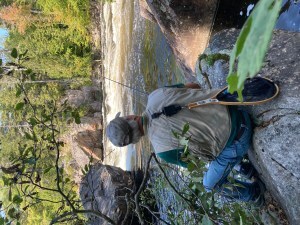
Hot Sept kept fish hiding. We hiked into some shaded pools. I did safety patrol (very big rapid) while Bob tried various flies with no takers.

squirrel
I’ve been camping at the Penobscot River for a while. No cell or wifi (heaven!) but did some Robert Parker searches for this post before I prepped and packed 10 days of food for my husband and me and the 2 dogs. (Who wants to leave the river and shop?)
I often think about how to “Parker-ize” my writing: keep my own style and voice for the mystery series but lean it down to its bones …so to speak. Parker-ize it. (My term.) I listen and re-listen to his books on tape as I drive. (Joe Mantegna’s narration delivers a to-die-for Boston/ Spenser incarnation. Here’s a short listen.)
Sometimes, I have to pull over and replay a bit over and over.
When asked about his popularity, Parker said, ““I dunno. I think people just like the way it sounds.”
Oh yes.
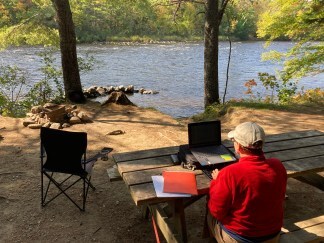
My Penobscot office. (Fishing happened early AM and dusk. Sitting listening to the river not doing much: all the time.)
I think novelist Lisa Scottoline says the craft part well.
“ … My writerly voice is my own … I would never learn anything about voice from anybody else, even the best writer, because voice is something that comes from the soul…. Voice is something you finally hear, and refine, when you let your doubts and insecurities fall away, and what’s left is your truest and most authentic self, or your character’s truest or authentic self. That said, when I read, I learn something about writing and writing technique from every single book I’ve read. And that is nowhere truer than in the genre we all love, which is crime fiction.
… And when books by the same author work perfectly over time, that’s when I learn the most.
Case in point?
The late Robert Parker.
But there is one lesson in particular I learned from reading him, and I remind myself of it every day when I sit down at the computer. It’s a technical one, but let me suggest that the importance of technique can never be underestimated, and a page-turner gets readers turning the pages only if the author is paying attention to technique.
Reading Robert Parker taught me that what you leave out is just as important as what you put in, and maybe even more so. And in the Spenser books in particular, he leaves out many of the details that even the best writers conventionally include. Take a look at Small Vices, when you get a chance. In its first chapter, Spenser goes to see assistant DA Rita Fiore and they meet in her office. Parker tells you that the office is on the 39th floor, and after that he says absolutely nothing about what the office looks like. Nothing.
Parker mentions the view from the window, but that’s it. … When I first read this, I admit I was surprised. I wondered how the reader could picture the setting if Parker didn’t let us know what it looked like. Then I realized that Parker is way smarter than I am. Because what he gained was a focus on character, plot, and story, and the fact is, it doesn’t matter in the least what the office looked like, to Spenser or to the reader.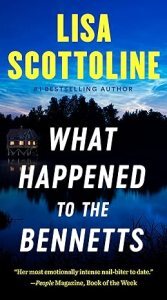
What I learned from reading Robert Parker brought me to the realization that reading and writing are the same thing. I say this because I used to feel guilty reading when I should’ve been working, and then I came to understand that even when I was reading, I was working. Writing is a job we teach ourselves, and we’re learning it when we read, as well as when we write. And that’s why we can learn from reading Parker’s, and others’, books.

Thank you, Robert Parker.
So thank you, Robert Parker.”
Lisa Scottoline is the New York Times bestselling author and Edgar award-winning author of 20 novels.
******
Sandy here again; check out this YouTube : I ty to Parker-ize by keeping it as lean as possible. Using the lesson that we “leave out might be more important than what we put in,” here are some of my own examples.
“V. Brinkman coming to kill me & wolves. Mark’s barn. Bring trucks. Lights. Chaos. DO NOT CALL 911. Help free wolves.” I sounded screechy. “Am sane.” (me: I edited out wordy dramatic details. Sounding “screechy seemed to do it. Having to reassure listeners she was “sane” suggested she wasn’t.)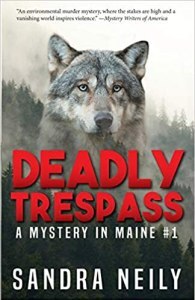
****
Open hands explored my spine, pausing on each rib, and then they started down my thighs, searching each muscle until they found the barbed wire wounds. The chants became soft moans, and I wondered what I was wearing for underwear. (me: What does it say that despite being injured she’s thinking underwear? Hands exploring her matter more than a first aid moment? I thought “underwear” got right to it.)
****
I faced the lake, closed my eyes, and felt for buried current where a restless river pressed its dark weight against thick walls. I sent the river some hope. One day, probably after we’re long gone, you’ll find the right cracks.
(me: I got rid of dam description details and left the lake, the buried current and the weight.)
****
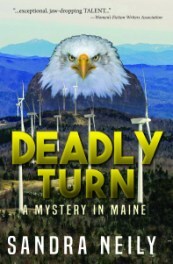 “Do I know you from a previous life?” I asked.
“Do I know you from a previous life?” I asked.
“Not sure I had one,” he answered, sucking smoke deeply into his open mouth. (me: I needed both mystery and something cocky for this character, but with few words. Listening to Parker’s Jessie Stone’s dialogue, really helped here.)
****
I knew I’d ruined the moment when Evan slapped his hands over his ears. “Christ! You do know you can’t fix the universe, don’t you? Years and years of listening to you until, until—” He stopped.
I thought I could finish his sentence—until I left you.
(me: Boom. She knows both her ex and herself at the same time.)
****
This iconic American crime writer, whose books have sold more than 6 million copies, died in 2010 and we not only lost Parker, we lost his best-known creation, Spenser.
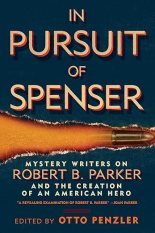 If you’d like more reaction to Robert Parker (whose books have sold over 6 million copies) “In Pursuit of Spenser” offers a look at Parker and his famous detective Spenser through the eyes of the writers he influenced. Editor Otto Penzler– proprietor of one of the oldest and largest mystery specialist bookstores in the country, collects some of today’s bestselling mystery authors to discuss Parker, his characters, the series, and their impact on the world.
If you’d like more reaction to Robert Parker (whose books have sold over 6 million copies) “In Pursuit of Spenser” offers a look at Parker and his famous detective Spenser through the eyes of the writers he influenced. Editor Otto Penzler– proprietor of one of the oldest and largest mystery specialist bookstores in the country, collects some of today’s bestselling mystery authors to discuss Parker, his characters, the series, and their impact on the world.
Oh yes, he sounds good.
“Asking your husband to go one-on-one with Joe Broz is like putting a guppy in the piranha pool. If we don’t find him before Broz does, he’ll be eaten alive.” ― Robert B. Parker, The Godwulf Manuscript
PS: Here, lots of authors weigh in on Parker after his passing.
September 18, 2024
The writing process, kind of, in pictures
As I finalize my book for its upcoming publication, I’ve got no gas left in the tank for one of my usual lengthy posts. Lucky you!
Instead, I’m posting a few pictures to illustrate my writing process. Remember, aspiring writers, there is no right or wrong process. It’s whatever works for you. This is what’s evolved over the years at four-plus books. You may not want to try this at home.
There’s always a lot of talk about “plotters” — people who outline their books — and “pantsers” — people who go by the seat of their pants. My guess is that most writers fall somewhere in between.
I usually start with a lot of notes and other stuff, and some definite ideas about what’s going to happen, but no firm outline. I do it that way because I’ve found writing itself reveals the book to me. A lot of it won’t be clear until I start writing. The writers who are reading this either think this is either crazy-ass bull, or total validation.
Once I’m about 100 pages in and have kind of figured out where things are going, I outline what I’ve done, then continue to outline as I write — not in advance, but get down what I’m doing. I do it on a large whiteboard, and it’s color-coded for POV and some other elements. Why a whiteboard? Because I move things around. A lot.
I’ve also learned to separate the manuscript into scenes, not chapters, since scenes get added, deleted, or moved around, so trying to set it up with chapters would just make it more of a mess as things change.
 By the time I’m done with the “first draft,” it looks something like this. The blank right side was for notes on things that had to be addressed, or not to forget about, and changed daily.
By the time I’m done with the “first draft,” it looks something like this. The blank right side was for notes on things that had to be addressed, or not to forget about, and changed daily.
The orange lines within the outline are to separate the day and date in the story, so I don’t lose track of that. (BTW, if you don’t want any spoilers and can actually read my scrawl, don’t look too close. Though, as you’ll see, things change anyway.)
I take a photo once I’m at the end in case there’s anything I need to remember. Then, as I prepare to start revising, I erase the whole thing.
My first drafts are quite large — this one was 175,000 words. I’m not kidding. But don’t worry, the final version is much smaller. I don’t focus as much on the writing the first time around, just try to get the story down. There’s a lot of unneeded exposition and backstory, as well as scenes I don’t need as I play around with plot — I know a lot of this will come out, but I don’t consider it “wasted writing.” It’s like the big block of marble that the eventual sculpture will emerge from.
In the revision, the outline becomes more detailed with the date and day at the top of the scenes that happen that day (to give me more room for the other stuff in the column). I still outline as I revise. The scenes on the board are what’s been revised. Specific clues, theme, and plotlines all are more specifically noted.
I don’t sort the scenes into chapters until it’s ready to go to the editor. I generally like to have three scenes a chapter, but it depends on what’s going on structurally. I don’t like chapters to be too long — 10-15 words is my target — so some long scenes are their own chapter.
This is how the revision looked shortly after I started it. The column on the right is now the linear plot of the book (not a synopsis, but the actual who did what and when), so I can make sure it’s flowing through the scenes well and I get the clues in the right places. My daily notes to myself are on the small greenboard on the table.
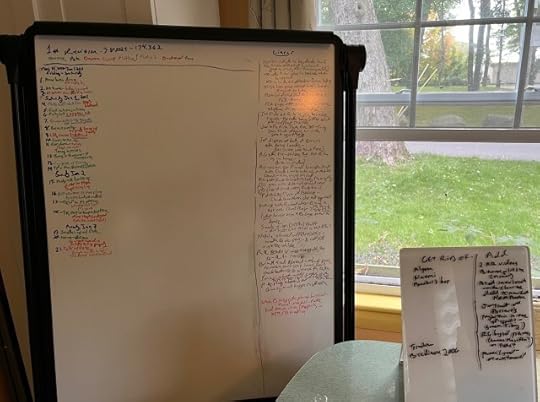
I know you’re thinking, wow, Maureen’s writing space looks pretty cool! Wish I could see more.
Yes! Ha ha. I write at my kitchen table. It’s funny, because I don’t do my non-mystery writing work there or anything else, except eat. But I’ve found it’s the best place to write my books. I’m not sure why, I just ended up there. Maybe it’s the view out the window, which is just enough to keep my from growing insane (the way staring at a wall would), without being super-distracting. There’s also plenty of room for my notes, and I can keep everything there without having to move it for any reason.
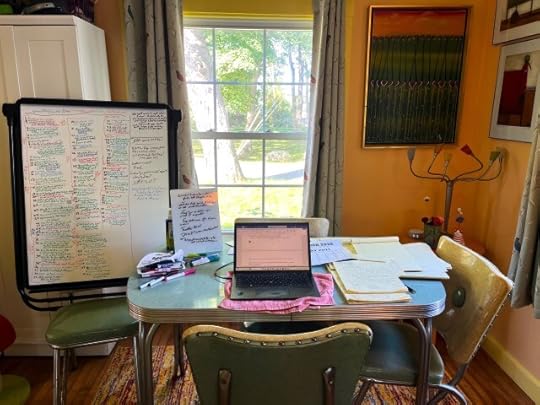
If you’re thinking, boy, writing looks complicated! Yeah, it is. At least the way I do it.
How do I recharge my brain? You guessed it. Jigsaw puzzles! Since last fall, I’ve gone through four 1,000-piece jigsaw puzzles that I do on a big foam board on my coffee table while I’m “watching” something on TV that doesn’t require my total attention.
Yes, there are many inefficiencies to that, more than I want to go into. But the brain wants what the brain wants.
Here’s my latest, The World of James Joyce. The previous one was The World of Charles Dickens, which is my favorite so far, but I didn’t take a photo of it.
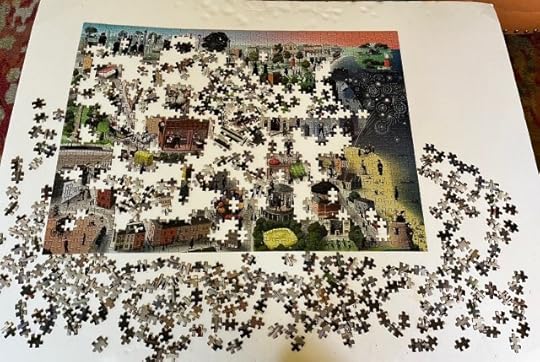
Ok! I think that covers everything you need to know about how writing a book works. Go get ’em!
Oh yeah, if you want to see how all this came out, look for the fourth book in my Bernadette “Bernie” O’Dea mystery series, DYING FOR NEWS, October 29.
September 17, 2024
Series Mysteries and Those Surprising Detours

Thea Kozak series, book 1
Kate Flora: As I’m coming into the end zone on the latest Joe Burgess police procedural–and probably because it’s fall, which is always a time for reflection–I’ve been thinking about the peculiar journey my work has taken since my first mystery, Chosen for Death, was published back in 1994.
In 1994, my writing rhythm was to write for nine months and then 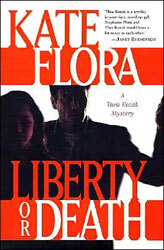 promote for three. That’s all history now, since writers have to do most of the promotion and the promotion cycle, much due to social media, never slows down. Back then, though, I was very happy writing my Thea Kozak series and expected that would be my writing career. That was derailed when the publisher abruptly dropped the series after book six, Liberty or Death.
promote for three. That’s all history now, since writers have to do most of the promotion and the promotion cycle, much due to social media, never slows down. Back then, though, I was very happy writing my Thea Kozak series and expected that would be my writing career. That was derailed when the publisher abruptly dropped the series after book six, Liberty or Death.
That publisher’s decision, once I recovered from my despair, led me in a new direction. Because all mysteries with homicides involve the police, and because Thea had gotten involved with a Maine state trooper, I was spending a lot of time with police asking questions. So it seemed natural that the next step would be to write a police procedural. That brought me up against the question: I know how to write strong women but how do I write a trio of middle aged male cops? It was an adventure that led me to Playing God, my first Joe Burgess mystery.
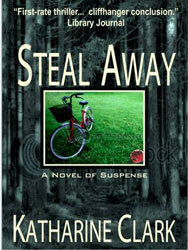 But somewhere along that path curiosity about the difference between mystery and thriller had led me in a different direction. What would it be like to write a book that was not a who dunnit/why dunnit but a race against time. Will the good guys prevail before the bad guys kill a child? Who are the bad guys and what are their motives? All of that wondering–and wondering is what we’re always doing–led to my first multiple viewpoint book, Steal Away. In order to give the book its best chance, and put some distance between my series mysteries, Steal Away was published under a pseudonym, Katharine Clark.
But somewhere along that path curiosity about the difference between mystery and thriller had led me in a different direction. What would it be like to write a book that was not a who dunnit/why dunnit but a race against time. Will the good guys prevail before the bad guys kill a child? Who are the bad guys and what are their motives? All of that wondering–and wondering is what we’re always doing–led to my first multiple viewpoint book, Steal Away. In order to give the book its best chance, and put some distance between my series mysteries, Steal Away was published under a pseudonym, Katharine Clark.
I loved writing it, but, at least for me, when you write series characters they become friends. I found when I ‘d finished it that I was curious about what my characters were up to, and wrote another Thea. My agent for Steal Away, though, wasn’t interested in series mysteries and wanted me to write another thriller. I started writing a second thriller, a political thriller, working title Spring Break, about a college student on spring break who discovers everything she’d taken for granted in life wasn’t true. Her boyfriend betrays her. Her mother is attached and in a coma. And her beloved father reveals that her real father is a politician running for president. My agent wasn’t excited about the book, the relationship ended, and I went back to series mysteries.
But of course, another detour lay ahead. Research for the Joe Burgess procedurals led me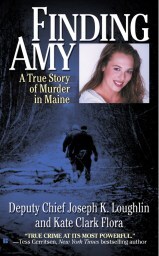 to the Portland, Maine police department. Then Lt. Joseph Loughlin became my go-to guy for information about police procedure. And a few years into our friendship, Amy St. Laurent was murdered and Joe wanted to write about the case. I became his writing advisor and eventually his co-write on a true crime, Finding Amy. Writing that book was an amazing experience, one that led me to say that the previous years of writing had been preparation for the honor of telling Amy’s story. But writing true crime, and living with a real homicide victim in my head for years, was too hard. I was glad to be able to return to fiction.
to the Portland, Maine police department. Then Lt. Joseph Loughlin became my go-to guy for information about police procedure. And a few years into our friendship, Amy St. Laurent was murdered and Joe wanted to write about the case. I became his writing advisor and eventually his co-write on a true crime, Finding Amy. Writing that book was an amazing experience, one that led me to say that the previous years of writing had been preparation for the honor of telling Amy’s story. But writing true crime, and living with a real homicide victim in my head for years, was too hard. I was glad to be able to return to fiction.
The writing years went on. At some point, I took another detour into thriller writing when a newspaper headline about yet another teacher who’d had an affair with student caught my eye. I thought–what if I flipped the script? What if the teacher is innocent but the student is obsessed with her? What if he proposes the affair, she turns him down, and he sets out to destroy her? That eventually became Teach Her a Lesson, published last year by Encircle. But that book went through about twelve years and a dozen writes before it was finally published.
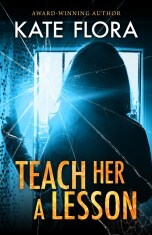 Meanwhile, though I was happily alternating between Thea and Joe, I realized that writing true crime had been a very different, immersive experience. That it had forced me out of my office, away from my desk, and made my timid self go and talk to people (read cops) who could tell me the real story of a real crime. I realized that, intimidating as it was, I missed that adventure and the challenge of figuring out how to tell a true story. So, following up on warden Lt. Pat Dorian’s comment at the Finding Amy launch, “When you’re ready, Kate, I have another one for you,” I called him up and found myself immersed in another story. That led to multiple trips to Miramichi, New Brunswick, friendships with some wonderful police officers, and a second true crime, Death Dealer.
Meanwhile, though I was happily alternating between Thea and Joe, I realized that writing true crime had been a very different, immersive experience. That it had forced me out of my office, away from my desk, and made my timid self go and talk to people (read cops) who could tell me the real story of a real crime. I realized that, intimidating as it was, I missed that adventure and the challenge of figuring out how to tell a true story. So, following up on warden Lt. Pat Dorian’s comment at the Finding Amy launch, “When you’re ready, Kate, I have another one for you,” I called him up and found myself immersed in another story. That led to multiple trips to Miramichi, New Brunswick, friendships with some wonderful police officers, and a second true crime, Death Dealer.
Once again, despite the warmth and generosity of those officers and those in the Maine warden service, I was glad to leave the real behind and return to the world of imagined crime. More Thea. More Burgess. A swerve into a non-mystery, Memorial Acts, that still lives in the drawer. And then, again under the guise of helping a non-writer tell his story, I ended up in a retired Maine game warden’s green pickup truck, driving around the dirt roads near Moosehead Lake. While I held a tape recorder, his wife sat in the back seat with a shotgun, Roger Guay, the warden who, with his dog, had found Amy’s body, told stories of his 25 years in the Maine woods.
Once again, I was stepping out of my comfort zone to help someone tell an important  story. I hadn’t known how to write series mysteries. I hadn’t known how to write thrillers. I certainly hadn’t known how to write true crime. Now I was learning how to write memoir. The result was A Good Man with a Dog.
story. I hadn’t known how to write series mysteries. I hadn’t known how to write thrillers. I certainly hadn’t known how to write true crime. Now I was learning how to write memoir. The result was A Good Man with a Dog.
My agent told me that I should stick to writing one thing and build a platform as that writer, but I’ve always thought a writer should write what she’s compelled to write. What she’s drawn to.
And now, many years after I first tried to follow up Steal Away with another triller, that book, now titled Burn the Diaries and Run, will be published by Encircle in October, and I’m thrilled. Here’s the blurb:
Jenny Cates thought her life couldn’t get worse after her boyfriend’s betrayal. But when her mother is attacked, and she discovers the man she thought was her father isn’t, Jenny is thrust into a deadly game. On the run from two ruthless politicians—one who wants her dead, the other who wants to use her—Jenny must rely on her own strength to survive. Armed with her mother’s secret diaries, she’s determined to expose the truth and destroy the campaigns of the men hunting her down.

September 15, 2024
Comic Book Heroes
Kaitlyn Dunnett/Kathy Lynn Emerson here. The other day, while going through the movies we own, either on DVD or through streaming, it dawned on me that many of my favorites, and a fair percentage of the total, are based on comic books (or graphic novels, if you prefer).
 I can’t say I was surprised. I was reading the “funny pages” in the Sunday newspaper early on. As I recall, my favorites were “Prince Valiant,” “Terry and the Pirates,” “Brenda Starr,” and “Winnie Winkle.” I was also quite young when my father and I got into the habit of after-supper walks to Watson’s, a small diner nearby where he could get a cup of coffee and I could browse the rack of comic books. I’d pick one to buy and read it at the counter until it was time to walk home again. Without fail, George Watson would say, “you already read that one. Why don’t you put it back and take a different one.” I’d always thank him but refuse. I was a bit of a book-hoarder even then, and we had a cabinet in our partially finished basement that had lots of drawers just the right size for sorting and storing.
I can’t say I was surprised. I was reading the “funny pages” in the Sunday newspaper early on. As I recall, my favorites were “Prince Valiant,” “Terry and the Pirates,” “Brenda Starr,” and “Winnie Winkle.” I was also quite young when my father and I got into the habit of after-supper walks to Watson’s, a small diner nearby where he could get a cup of coffee and I could browse the rack of comic books. I’d pick one to buy and read it at the counter until it was time to walk home again. Without fail, George Watson would say, “you already read that one. Why don’t you put it back and take a different one.” I’d always thank him but refuse. I was a bit of a book-hoarder even then, and we had a cabinet in our partially finished basement that had lots of drawers just the right size for sorting and storing.
 What comic books did I keep? Remember that I was both young and female. Scrooge McDuck and comic book versions of Disney animated movies were early favorites. I still have my copies of Peter Pan and Sleeping Beauty. A bit later I was heavily into Katy Keene, but I also eagerly read the adventures of The Phantom and Superman. I’m pretty sure I also read Wonder Woman comics, but I can’t swear to it. At the same time, on TV, was was a big fan of Mighty Mouse Playhouse on CBS (1955+) and even formed a Mighty Mouse Fan Club with two friends. And, of course, I read some of the “Classics” in comic book format, although I can’t say I was any more enamored of those versions than of the actual long, boring original versions so loved by English teachers.
What comic books did I keep? Remember that I was both young and female. Scrooge McDuck and comic book versions of Disney animated movies were early favorites. I still have my copies of Peter Pan and Sleeping Beauty. A bit later I was heavily into Katy Keene, but I also eagerly read the adventures of The Phantom and Superman. I’m pretty sure I also read Wonder Woman comics, but I can’t swear to it. At the same time, on TV, was was a big fan of Mighty Mouse Playhouse on CBS (1955+) and even formed a Mighty Mouse Fan Club with two friends. And, of course, I read some of the “Classics” in comic book format, although I can’t say I was any more enamored of those versions than of the actual long, boring original versions so loved by English teachers.
Anyway, getting back to movies, it should come as no surprise to anyone, myself included, that I own and rewatch a fair number of entries from the Marvel and D.C. universes. As an aside, have to admit it took Jason Mamoa to make me an Aquaman fan, and I never really got into Batman.

I also own the 1989 film version of Brenda Starr (there others released in 1945,1976, and 1979, but I don’t think I’ve ever seen any of them) and I recently watched a rather fascinating version of Prince Valiant from 1997 (an earlier movie was made in 1954). It starred the actor who played Vampire Bill in True Blood as Prince Valiant and Katherine Heigl as his love interest.
What other movies in my collection were originally comics? Argylle is the most recent addition—I found it hilarious, by the way, although many people apparently didn’t “get” it. Then there is RED with Bruce Willis, Lara Croft, Tomb Raider, the whole X-Men series (Marvel, but separate until recently from the Avengers, Iron Man, Black Panther, etc. world), and the Men in Black movies.

So, why do I seem to have a weakness for the genre? I think it’s partly because I prefer escapism to too much reality in my entertainment, but quite possibly it is also because both the comics and the movies are far removed from the sort of thing I write. I read a lot of Regency-era historical romance for the same reason, but that’s a topic for another blog.
What about you, readers? Are you a fan of a genre others might not expect you to read and/or watch?

Kathy Lynn Emerson/Kaitlyn Dunnett has had sixty-four books traditionally published and has self published others. She won the Agatha Award and was an Anthony and Macavity finalist for best mystery nonfiction of 2008 for How to Write Killer Historical Mysteries and was an Agatha Award finalist in 2015 in the best mystery short story category. In 2023 she won the Lea Wait Award for “excellence and achievement” from the Maine Writers and Publishers Alliance. She was the Malice Domestic Guest of Honor in 2014. She is currently working on creating new omnibus e-book editions of her backlist titles. Her website is www.KathyLynnEmerson.com.
September 13, 2024
Weekend Update: September 14-15, 2024
 Next week at Maine Crime Writers there will be posts by Kaitlyn Dunnett/Kathy Lynn Emerson (Monday), Kate Flora (Tuesday), Maureen Milliken (Thursday), and Sandra Neily (Friday).
Next week at Maine Crime Writers there will be posts by Kaitlyn Dunnett/Kathy Lynn Emerson (Monday), Kate Flora (Tuesday), Maureen Milliken (Thursday), and Sandra Neily (Friday).
In the news department, here’s what’s happening with some of us who blog regularly at Maine Crime Writers: Vaughn Hardackerwill be selling and signing books at Trasn & Treasures at the Forum in Presque Isle on September 14 and 15.
An invitation to readers of this blog: Do you have news relating to Maine, Crime, or Writing? We’d love to hear from you. Just comment below to share.
And a reminder: If your library, school, or organization is looking for a speaker, we are often available to talk about the writing process, research, where we get our ideas, and other mysteries of the business, along with the very popular “Making a Mystery” with audience participation, and “Casting Call: How We Staff Our Mysteries.” We also do programs on Zoom. Contact Kate Flora
September 12, 2024
How I Think I Write vs. How I Actually Write
Rob Kelley here, continuing to learn what my actual writing process is versus what I imagine to be.
One of the books that was the talk of this year’s Maine Crime Wave was Matt Bell’s Refuse to Be Done: How to Write and Rewrite a Novel in Three Drafts. 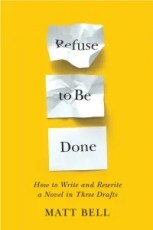 The title sounds so deliciously reductive. Three drafts? Hell yeah, sign me up!
The title sounds so deliciously reductive. Three drafts? Hell yeah, sign me up!
That’s four drafts shorter than Allison K. Williams’ Seven Drafts: Self-Edit Like a Pro from Blank Page to Book,  a book I’ve written about before as a great primer on recursive editing.
a book I’ve written about before as a great primer on recursive editing.
But here’s the thing. Those three drafts? They are essentially three whole books. Bell advocates a second draft that is a complete rewrite. No line editing, no cut and paste. Write draft one, create an outline of the book it should be, then write that new book, all fresh and clean.
Seriously? No way I’m doing that. That’s insane. Who would even do that?
Turns out, me; I just didn’t acknowledge it. I’m drafting my third novel now, and after my first draft and some tweaks to the outline, I began editing it this summer. But it fought back. Hard. That book, the one I’d drafted, just wasn’t strong enough. In fact, one of its central thriller premises, the idea that generated the book in the first place, wasn’t working at all and had to go entirely.
I looked and saw that this book sucked. The voice of the protagonist? Too weak, not relatable. The villain, more interesting, but a little stock. The plot? Forced, even maybe cliche. My actual writing process? Not what I thought. In actuality it was: try to edit a first draft, find that it couldn’t be edited into the book it needed to be, agonize, complain, then admit to myself that it had to be re-written in its entirety. And, in actuality, I did this every time.
I stalled trying to do a second draft about halfway through the book, just as I had–I now realized–on my forthcoming book Raven (High Frequency Press, 2025), and my second book, tentatively titled Critical State. I’d drafted something I really liked, gave it a little breathing room, then came back to revise it and hit a brick wall.
I always encountered that wall and eventually found way around it (or, rather, through it!), and each time the solution was the same: a fundamental rewrite from scratch, a rethinking of the backstory, the complications, the ticking clock, the stakes for the protagonist, the agency and centrality of the protagonist, the subtlety and flaws of the antagonist. All the stuff that makes a much stronger story. All the stuff you cannot reliably do when you are first getting out the ideas that become your book. You get a few right, sometimes even a few in a row, but the structure that a reader loves, the slow burn, the reveals, the stakes, all require a more subtle hand. Only then could I see the angel in the marble and carve to set him free, as Michelangelo purportedly said.
It’s actually a fundamental flaw in my self-conception of my first drafts. I’m a plotter, so I like to think that my first draft is a well-crafted literary machine, already tuned and balanced, but the truth is, it’s mostly a slab of marble. Raw material that I then need to consciously and meticulously reorder, refine, reduce into a real story, a story that meets the expectations I had when I started that first draft. And that only happens when I hit that brick wall and have to face that my amazing first draft isn’t, actually, that amazing. Really nice marble; not a statue.
So this week, as I began that process of rethinking book three and making the hard decisions about killing a few, or more, darlings, I pulled Refuse to Be Done out from the bookshelf, read the section on the second draft again, and found it rang entirely true. Then I revised the snarky comments I’d made in my reading notes for the book to reflect the fact that I now actually got what he was saying.
And that second draft? It might take as long as the first one. Months. A year. Because then, and only then, will I be writing the book I actually intended to write.
September 11, 2024
Are Your Characters Realistic?
Vaughn Hardacker here: One of the things that will turn me off from a book is Tom Swift-style characters, you know, the hero who excels at everything they have ever done. For example, the Great Leslie Gallant is the character of the Warner Brothers’ 1965 movie, THE GREAT RACE. The movie is one of my all-time favorites and a great satire. However, the characters are, by intent, shallow. Tony Curtis as Great Leslie is the protagonist, and Jack Lemmon is Professor Fate Leslie’s nemesis and antagonist. Are satirical illustrations of the heroes and villains of silent films. The problem is they are one-dimensional (albeit, I believe, intentionally so).
We writers must never forget that people are not one or even two-dimensional. They are multi-faceted. They have hopes and fears, hates, likes, and failures. Yet, we tend to focus on one or two dominant traits when considering their personalities. We describe someone we know to another person as “He’s the pushy one.” Or “She’s so sweet but a bit ditsy.” It’s what, in our minds, makes these people individuals to us. So, too, the characters we write must be multi-faceted. When we write them as such, they blend into one another with no personality distinctions. Their physical attributes differ, but you could probably swap around and notice little difference. The most recent rejection letter says, “Your characters are cookie-cutter.” Of course, in your mind, you (as the writer) see all these “people” as distinct. Remember the way we describe people? Define your characters the same way. Give your hero two or three traits. That’s all. Give him two good and one bad (or two bad and one good, if your character is evil). Lesser characters get fewer traits.

2023
In my most recent novel, my protagonist is a retired hitman (which I believe is an oxymoron) who is moral in that he has strict rules about whether he will or will not hit a particular target (a good thing) and can be loyal (another good thing). Still, when he feels that he’s been taken advantage of, he’s brutal (bad). My antagonist, by necessity, is almost the opposite: arrogant (bad) and bereft of any semblance of ethics or behavior (bad), which makes him a bully. I try to make all of my writing character-driven (we have to, after all, virtually every plot today is derived from Shakespeare), so even though there’s a “bad guy” in my Bouchard and Houston novels, one of my readers’ favorite characters is an anti-hero. Jimmy O is a

2015
protagonist who could easily be the antagonist. However, as interesting as many of my readers have found him, he’s a supporting character (they get only two traits; in Jimmy O’s case, he can be a brutal and violent mobster while, on the other hand, he uses that trait to help people less fortunate than he). A member of one of my writing groups said he is a gangster with morals.
It’s important to remember that sometimes stories change as we write them. A minor character (Jimmy O) could suddenly become important and move into a supporting character role. If this happens, give that character one more trait. But only one; you don’t want to interfere with the importance of the primary characters. Likewise, a supporting character may fall back to supporting status. In that case, focus on just one of his chosen traits. The most important thing to remember is your character’s role in the story … does his or her presence move the story forward? If you don’t know that, your characters will have too many traits, and once again, they’ll become cookie-cutter people with different roles.
September 10, 2024
The Horror of First Drafts!
I started a new novel. Now let me tell you, it’s been about three years since I stared at a blank page. It’s not that I haven’t been writing these past few years. I’ve been editing a bunch of manuscripts that I wrote during the pandemic. And editing, as most writers know, is a far different skill than writing a first draft. I love the editing process, although don’t ask me that while I’m editing.
But creating something from nothing is different. It’s really, really hard.
As far as first drafts go, Marlon Brando, playing Colonel Kurtz, said it the best in the movie Apocalypse Now: THE HORROR! I’d forgotten how hard it is to write a first draft, even knowing the story of what I was going to write. The sheer terror of venturing into the unknown with unknown characters is a daunting task, and one that I was not entirely ready for. Character after character keeps showing up that I’d never anticipated. More third person close narrators and that scares me. How long will this book be?
Now, I’ve written twelve novels. So why did the terreur, as the French call it, strike me so hard this time? Was it because of the time lapse between books? Was I not as confident in my plot as I thought I would be? I’m not entirely sure why. It just happened. And now I have to deal with. Keep on plugging.
I keep asking myself how I ever wrote twelve novels. And how do authors do this. And yet I keep typing away to the plot’s inevitable, if unknowable, conclusion.
Of course, and there’s always an of course, it gets better with time. And the more you write, the more likely you’ll forget about the terrors and get involved with your plot and your characters lives. How to save these people and make them better. Or worse. You dip your hands in the mud of creation and muck around like a demi-god. Then the terrors start all over again the next day, although they diminish a wee bit with every chapter written.
A secret most writers share is that we forgive ourselves for that first crappy draft. “Father forgive me for I have sinned. My first draft was a complete disaster.” But that’s okay. With experience we accept this outcome and understand it for what it is. Yes, we accept crap because we know, or at least we believe, that even a shitty story filled with holes and inconsistencies can still be salvaged (even if we know that sometimes it can’t be salvaged). Fix it and they will come. And in writing, editing is key. We pray that the editing process will pull this manuscript through.
Whether you’re a panster or plotter, “write on” as Matt Cost likes to say. It’s good advice. The terrors can’t be helped, but an acceptance of the entire writing process helps alleviate them as one writes. The key is to put one’s butt in the chair and write. Write until you can’t write anymore, wiser in the knowledge that vigorous edits will make the novel as good as it can be.
With that said, I’ll quote Matt Cost again and encourage all you authors to WRITE ON if you want to keep those terrors in check.
September 6, 2024
Weekend Update: September 7-8, 2024
 Next week at Maine Crime Writers there will be posts by Jule Selbo (Monday), Joe Souza (Tuesday), Vaughn Hardacker (Thursday), and Rob Kelley (Friday).
Next week at Maine Crime Writers there will be posts by Jule Selbo (Monday), Joe Souza (Tuesday), Vaughn Hardacker (Thursday), and Rob Kelley (Friday).
In the news department, here’s what’s happening with some of us who blog regularly at Maine Crime Writers:
For those who heard her great talk at the Crime Wave, and those who didn’t but would love to meet brilliant editor and author Juliet Grames, there’s this:
Gulf of Maine Books and Vessel and Vine are teaming up to bring you an Italian mystery night, with wine. We will be celebrating with author Juliet Grames, and her new novel “The Lost Boy of Santa Chionia, set in the wilds of inner Calabria. The event will take place at Vessel and Vine (just behind the bookstore, on Pleasant Street) on Sept. 10, 6-8 PM. The evening will include Juliet reading from the book and in conversation with Gary Lawless. The admission price of $25 includes a glass of Calabrian wine and appetizers (of course more wine will be available for purchase). There are only 30 places, so please act quickly if you would like to join us. Please contact Gulf of Maine Books 729-5083, or drop by the bookstore for tickets or for more information.
The book has just been published, and is available at Gulf of Maine or at the event.
Come and hear the author, have a glass of wine, and venture off to Calabria!!
from Kathy Lynn Emerson: I’m continuing to bring out newly edited trade paperbacks of the books in my Face Down Mystery series. Face Down Before Rebel Hooves (book six) was released on September 5, joining Face Down in the Marrow-Bone Pie, Face Down Upon an Herbal, Face Down Among the Winchester Geese, Face Down Beneath the Eleanor Cross, and Face Down Under the Wych Elm. In this one, it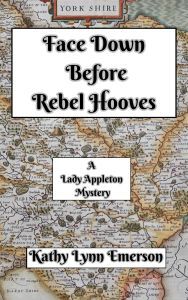 is 1569. In the north of England, two Catholic earls and their countesses are plotting rebellion. In an attempt to stop what became known as the Rising of the Northern Earls, spymaster Walter Pendennis asks for help from sixteenth-century gentlewoman, herbalist, and sleuth, Susanna, Lady Appleton. Embedded in the countess of Northumberland’s household under an assumed identity, she has a front row seat as history unfolds. The Bangor Daily News called Face Down Before Rebel Hooves “The most satisfying book in the series.” The trade paperbacks sell for $15.99 each and can be ordered by any bookstore or library. For e-book editions, the text is identical in the three Face Down Collections, which contain all the novels and short stories. Please note that the individual e-books available online contain older versions of the novels. The plots and characters are the same but I personally prefer the updated editions, which have been revised to get rid of wordiness, the occasional historical or continuity error, and a few other minor issues.
is 1569. In the north of England, two Catholic earls and their countesses are plotting rebellion. In an attempt to stop what became known as the Rising of the Northern Earls, spymaster Walter Pendennis asks for help from sixteenth-century gentlewoman, herbalist, and sleuth, Susanna, Lady Appleton. Embedded in the countess of Northumberland’s household under an assumed identity, she has a front row seat as history unfolds. The Bangor Daily News called Face Down Before Rebel Hooves “The most satisfying book in the series.” The trade paperbacks sell for $15.99 each and can be ordered by any bookstore or library. For e-book editions, the text is identical in the three Face Down Collections, which contain all the novels and short stories. Please note that the individual e-books available online contain older versions of the novels. The plots and characters are the same but I personally prefer the updated editions, which have been revised to get rid of wordiness, the occasional historical or continuity error, and a few other minor issues.
Matt Cost will be doing a COST TALK at the Southport Memorial Library on September 12th at 6:30 p.m. The focus will be on the recent release of City Gone Askew. On September Friday, September 13th, Cost will be traveling to Springfield, Massachusetts to be on a panel for the Association of Rural and Small Libraries.
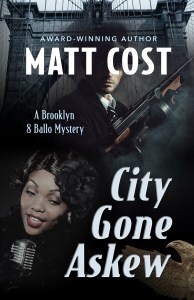
An invitation to readers of this blog: Do you have news relating to Maine, Crime, or Writing? We’d love to hear from you. Just comment below to share.
And a reminder: If your library, school, or organization is looking for a speaker, we are often available to talk about the writing process, research, where we get our ideas, and other mysteries of the business, along with the very popular “Making a Mystery” with audience participation, and “Casting Call: How We Staff Our Mysteries.” We also do programs on Zoom. Contact Kate Flora
Lea Wait's Blog
- Lea Wait's profile
- 509 followers



